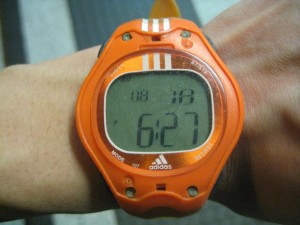The Joy of Metrics for Runners and Walkers
 “The joy of metrics for runners and walkers” sounds abstract but actually is real and very profound.
“The joy of metrics for runners and walkers” sounds abstract but actually is real and very profound.
I am using the word “metrics” here to refer to everything that you can use to measure how you are doing with your running or walking.
If you believe that you can’t improve what you can’t measure, and if you believe that improvements lead to greater happiness, then you appreciate how metrics can make a BIG difference in your happiness.
So, let’s take a look at some metrics that you can use as a runner or walker to raise your level of happiness.
The list of possible metrics could be huge, but I’ll keep it short to make a point. And, before you say to yourself that you are not a “numbers” person, please hear me out. My first metric requires no numbers…
An Analog Metric
My favorite “analog” (or subjective) metric — one that involes no numbers — is how tight my jeans or dress slacks feel, which tells me whether my weight has risen or fallen.
Dr. Brian Wansink wrote in his excellent book Mindless Eating that more than half of those in a 322-person survey pointed at their clothes to tell them that they had lost weight.
A New Distance
Colleen Murphy, who lost 120 lbs. in her transformation over the past few years from couch potato to ultramarathoner, writes about her journey at TheFitBee.com. Completing ever greater race distances has been a metric by which Colleen has measured her transformation.
The latest? Just six days ago she announced that she was attempting her first 100-miler!
Colleen gives us a powerful model of how to use race distance as a metric to measure improvement.
Garmin’s Virtual Partner
I finally paid attention this week to the “Virtual Partner” feature in my Garmin Forerunner 310XT, and I love it!
I earlier had used the pace-alert feature in a Garmin Forerunner 205, but that was a bit too “twitchy” in practice. I never mastered choosing a pace range outside of which the 205 would beep only rarely.
In contrast, the virtual-partner feature in the 310XT constantly tells you whether you are ahead of or behind schedule compared to your target pace. If the bottom of the Virtual Pacer screen is black, then you are behind schedule; otherwise, you are ahead of schedule — a very simple, dynamic metric! Plus, you can see how far and how many minutes you are ahead or behind schedule — two more metrics.
The Point?
Oh, so what was my point that I wanted to make by keeping this list short?
You can kill your happiness by measuring too much!
Pick just enough metrics that will bring you the most joy as a runner or walker, but don’t go overboard.
A Single-Metric Example
For example, you can lose weight without dieting by walking more than you normally walk every day while keeping your Caloric intake constant, but you need one crucial metric:
You have to measure how many steps you take each day!
I talk about this in my latest book — Weight Loss in 10,000 Steps a Day — released two days ago worldwide as a Kindle eBook (which you can read on an iPad or Android device, or in many other ways besides a Kindle reader).
What’s YOUR Favorite Metric?
What is your favorite metric for raising your performance — and your happiness — as a runner or walker?
Please tell your fellow readers and me by leaving a comment below! Then please keep the conversation going by clicking one of the “Share” links on this page. Thanks!